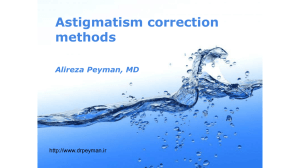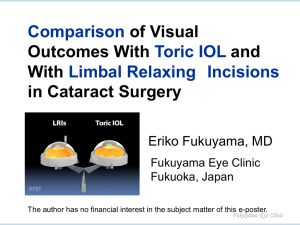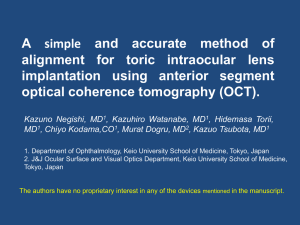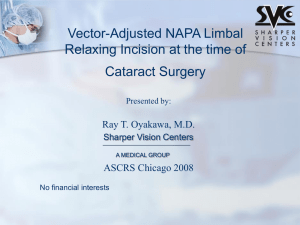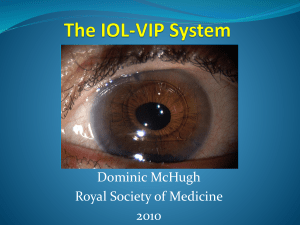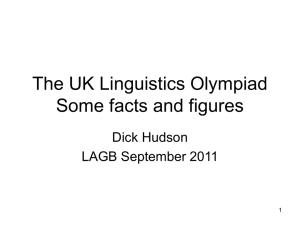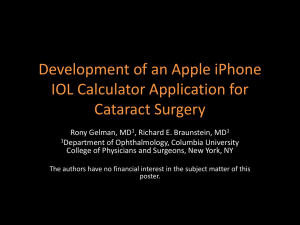Keratometry in Alcon AcrySof Toric IOL`s
advertisement
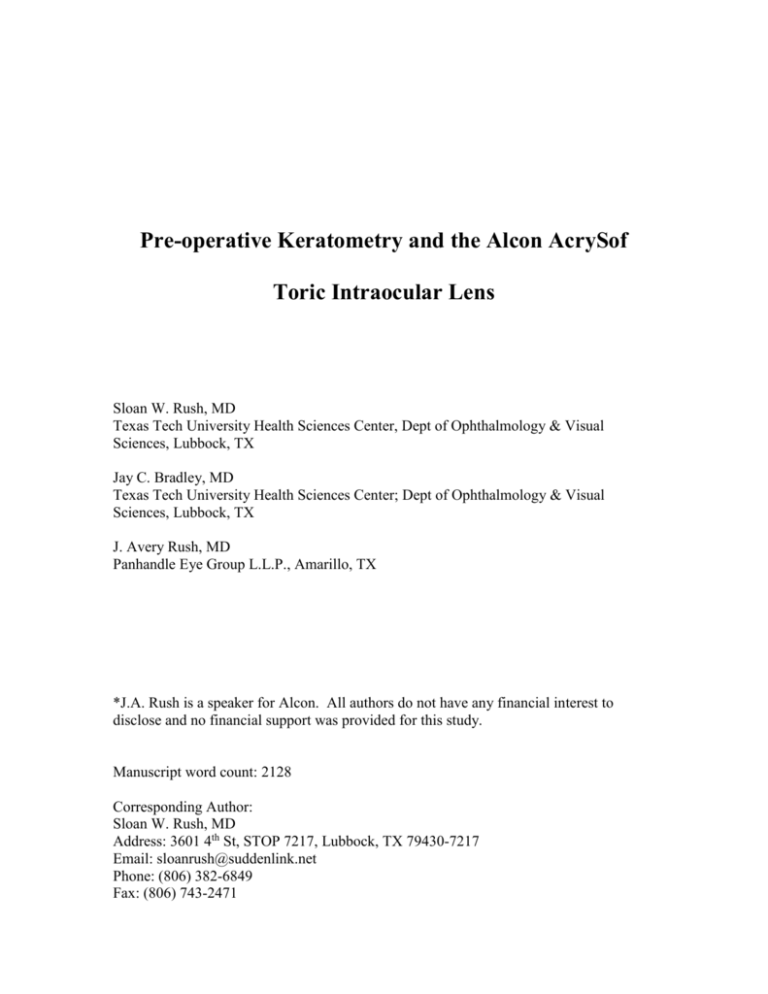
Pre-operative Keratometry and the Alcon AcrySof Toric Intraocular Lens Sloan W. Rush, MD Texas Tech University Health Sciences Center, Dept of Ophthalmology & Visual Sciences, Lubbock, TX Jay C. Bradley, MD Texas Tech University Health Sciences Center; Dept of Ophthalmology & Visual Sciences, Lubbock, TX J. Avery Rush, MD Panhandle Eye Group L.L.P., Amarillo, TX *J.A. Rush is a speaker for Alcon. All authors do not have any financial interest to disclose and no financial support was provided for this study. Manuscript word count: 2128 Corresponding Author: Sloan W. Rush, MD Address: 3601 4th St, STOP 7217, Lubbock, TX 79430-7217 Email: sloanrush@suddenlink.net Phone: (806) 382-6849 Fax: (806) 743-2471 Abstract: Purpose: To compare the accuracy of different preoperative keratometric methods for implantation of the Alcon AcrySof Toric Intraocular Lens (AASTIOL). Methods: One hundred consecutive cases (65 subjects) with AASTIOL implantation by the same surgeon were enrolled into the study for retrospective analysis. For each subject, the following data was collected: current glasses prescription, preoperative and postoperative refraction, manual keratometry, and automated keratometry using an autorefractor, a corneal topographer, and a Zeiss IOL Master. The calculated preoperative astigmatism was retrospectively determined for each subject using vector analysis. Absolute cylinder errors were then calculated by crossing the cylinder vectors of the resulting preoperative calculated astigmatism with the predicted cylinder for the various keratometric methods. Results: One-way analysis of the variance (ANOVA) was used to compare the means of the absolute cylinder errors for the four preoperative keratometric techniques. Absolute cylinder errors (in diopters with [95% confidence intervals]) from least to greatest are as follows: autorefractor 0.77 [0.66-0.88], corneal topography 0.83 [0.72-0.93], Zeiss IOL Master 0.84 [0.73-0.95], and manual keratometry 1.18 [1.07-1.29]. Automated keratometry techniques yielded cylinder errors significantly lower (p<0.05) than manual keratometry. There was no statistical difference in cylinder errors between methods of automated keratometry (p=0.5555). Conclusions: No single preoperative method of keratometry for predicting astigmatism was found to be extremely accurate in all cases, although methods of automated keratometry were superior to manual keratometry. Further investigation is necessary to determine the keratometric method to achieve most accurate and reliable postoperative refractive outcomes with AASTIOL use. Introduction: Refractive outcomes in cataract surgery patients have become increasingly important as additional methods for astigmatism correction become available.1 Routine astigmatic correction with cataract surgery is becoming the standard of care for many surgeons.2-3 Prior studies have used incisional techniques to obtain the desired postoperative refractive result4-5, but with the advent of toric intraocular lenses (IOL), astigmatic correction has become more predictable.6-8 Many toric lens implants have been described in the literature including the Artisan toric IOL for phakic correction of astigmatism9-10 and post-penetrating keratoplasty,11 Staar toric IOL for pseudophakic astigmatism correction,12 Nidek toric IOL,13 and Microsil silicone toric IOL.14 Toric IOL implantation has become progressively more common in the United States since Food & Drug Administration (FDA) approval and widespread availability of the Alcon AcrySof toric IOL (Alcon Laboratories, Inc, Fort Worth, Texas). Numerous calculation protocols have been proposed to determine the toric IOL power for implantation in cataract surgery15-16. For the Alcon AcrySof toric IOL (AASTIOL), the AASTIOL calculator (http://www.acrysoftoriccalculator.com) can be used to obtain the recommended cylinder power (either 1.50, 2.25, or 3.0 diopters in the lens plane) and axis of the IOL implant with input of the following: IOL spherical power (using the surgeon’s routinue technique and formula), anticipated surgically induced astigmatism (SIA) with incision location, and keratometry values (diopter value with axis of orientation in both the steep and flat axis). Previous investigators have looked at both the biometric spherical IOL calculation17 and the effects of SIA on toric IOL selection18, displaying that both are surgeon-dependent to varying degrees. The ideal method for obtaining pre-operative keratometry in patients undergoing toric IOL implantation has not been previously investigated, although manual keratometry was used and recommended based on the original FDA AASTIOL studies. Many methods are available to the practitioner for preoperative keratometry including manual keratometry and automated keratometry by an autorefractor, a corneal topographer, or the Zeiss IOL Master. The purpose of this study is to compare these various keratometric methods with regards to postoperative refractive outcomes when applied to the AASTIOL calculator. Materials and Methods: Sample data from a 100 consecutive cases (65 subjects) was collected in a retrospective fashion from patients that had phacoemulsification with implantation of the AASTIOL. Exclusion criteria included a history of prior ocular trauma, prior ocular surgery of any kind, keratoconus by history or by topography, anticipated Snellen visual acuity potential <20/40 post-operatively due to any reason (in order to ensure more accurate subjective pre- and postoperative refraction), or any intra- or postoperative complication. The AASTIOL calculator was used to determine which toric IOL was indicated. To maintain consistency, the same surgeon (J.A.R.) performed all cases with identical surgical technique using a clear cornea (superior 90 or temporal 180 degrees) 2.4 millimeter sutureless incision and performed all postoperative refractions (done for all subjects at the 3 week postoperative interval). Prior to each case, the same surgeon used a Mendez degree gauge (Katena Eye Instruments, Denville, NJ) to mark the 180 degree axis with the patient sitting upright and used this orientation to mark the axis of implantation intraoperatively just prior to toric IOL implantation. For each subject, the following measurements were obtained: lensometer reading (Zeiss Meditech, San Leandro, CA) of the patient’s current glasses, preoperative manifest refraction (Reichert phoropter, Depew, NY), manual keratometry (Marco, Jacksonville, FL), automated keratometry using an autorefractor (Zeiss Meditech, San Leandro, CA), corneal topography (Tomey, Phoenix, AZ), or the Zeiss IOL Master (Zeiss, Jena, Germany), and postoperative manifest refraction. Manual keratometry was performed by technicians with greater than ten years experience and history of consistent postoperative refractive outcomes. Particular attention was given to both pre- and postoperative manifest refractions in order ensure that occult cylinder was not present. All astigmatic measurements for the preoperative keratometric methods were rounded to the nearest whole number in terms of axis, to the nearest quarter diopter for refractions and glasses prescriptions, to the nearest eighth diopter for manual keratometry, and exactly as appeared on the objective print-out for each the autorefractor, the corneal topographer, and the IOL Master. Although a prior study showed that computation of cylinder power accounting for vertex distance from the spectacle plane to the corneal plane19 had a negligible effect on the results, old glasses prescriptions and pre- and postoperative refractions were adjusted to account for this issue to ensure accuracy. Several authors have advocated sophisticated mathematical methods for combining and calculating astigmatic vectors (i.e. a quantity with both magnitude and direction) across a population sample.20,21 In this study, the absolute cylinder error across various keratometric methods was analyzed and, by convention, all astigmatic vector quantities were formulated in the following fashion: magnitude of plus cylinder power in diopters and direction of axis in degrees 0-180. Irrespective of the keratometric method used for the AASTIOL calculator, the actual calculated preoperative cylinder was retrospectively calculated using vector analysis as previously described.22,23 The vector of the toric IOL power in the corneal plane with the axis of placement used during surgical implantation was added to the amount of SIA and the residual postoperative astigmatism as determined at the 3 week postoperative refraction. The AASTIOL power at the corneal plane is 1.03, 1.55, or 2.06 D according to the manufacturer depending on which of the three models is used. SIA was calculated using vector analysis of the difference between preoperative keratometric readings and postoperative astigmatism vertexed to the corneal plane as previously described.22,23 Absolute cylinder errors in diopters were calculated by crossing the cylinder vectors of the resulting preoperative calculated astigmatism with the predicted cylinder for each of the four keratometric methods. This particular method of vector analysis of the keratometric data is useful only for comparison of means across the sample population and that the calculated absolute cylinder error does not correspond with the postoperative clinical outcome. For example, if a patient has a calculated pre-operative cylinder of 2.00 D at 180 degrees and a particular keratometric method predicts 2.00 D at 165 degrees, it would appear that the keratometric measurement was fairly accurate. When using vector analysis, the difference between these two cylinders yields an absolute cylinder error of 1.04 D due to the 15 degree axis differential. This resulting absolute error does not correspond to a 1.04 D error in anticipated post-operative residual astigmatism and does not correlate with expected post-operative visual acuity but does however provide the most useful mathematical expression for comparison of means over the population sample. Results: Collected data was analyzed using one-way analysis of the variance (ANOVA) with statistical software (SAS Institute, Inc, North Carolina) to compare the means of the absolute cylinder errors for the four different preoperative keratometric techniques. Absolute cylinder errors (in diopters with [95% confidence intervals]) are presented in Table 1 from least (most accurate method) to greatest (least accurate method). When pooled together, there was strong statistical difference between the four methods (p<0.0001). For automated keratometry using an autorefractor, a corneal topographer, and a Zeiss IOL Master, cylinder errors were significantly lower (p<0.05) and found to be more accurate than manual keratometry when analyzed in pairs alone (student’s T-test). There was no statistical difference in cylinder errors between the autorefractor, corneal topography, and Zeiss IOL Master (p=0.5555). Only nine of one hundred eyes had more or within 0.25 diopters of astigmatism postoperatively than preoperatively. No significant IOL rotation was found in any patient enrolled in this study. In subjects that had >1 diopter absolute cylinder error for the autorefractor (n=30), both corneal topography and Zeiss IOL Master were significantly more accurate (p<0.05). In subjects with >1 diopter absolute cylinder error for corneal topography (n=29), both the autorefractor and Zeiss IOL Master were significantly more accurate (p<0.05). In subjects with >1 diopter absolute cylinder error for Zeiss IOL Master (n=30), both corneal topography and the autorefractor trended towards better accuracy but did not reach statistical significance (p=0.06 in both cases). Manual keratometry was found to be less accurate in the above mentioned subsets. In cases where the autorefractor, corneal topographer, and Zeiss IOL Master averaged >1 diopter of absolute cylinder error on one eye, it did not appear to increase the risk (by use of odds ratios) for subsequent inaccurate keratometric measurement on the fellow eye in the 35 cases in which both eyes were included in the study. Discussion: No single preoperative keratometric method for predicting astigmatism was found to be extremely accurate in all cases, although the three automated methods (autorefractor, corneal topography, and Zeiss IOL Master) were each found to be superior on average to manual keratometry. Although they can include a significant lenticular component, the old glasses prescription and preoperative refraction may be useful clinically if significant discrepancy exists among obtained keratometric methods. However, they should not be used alone for AASTIOL selection. Use of a corneal topographer able to measure the posterior corneal surface may also prove useful in select cases. Some inaccuracies observed in this study may be attributable to rotational instability or inaccurate initial placement of the toric IOL. Since several recent studies have confirmed the FDA findings of excellent rotational stability of the AASTIOL24-25, these factors likely did not significantly affect the refractive outcome. Occasionally, significant discrepancies occur among various preoperative keratometric methods. Accuracy in postoperative outcomes may be improved by selectively implanting AASTIOL only in patients with regular topography and highly consistent keratometric measurements among various methods. However, based on the data above, the accuracy of each automated keratometric methods is skewed in a minority of cases. Performing various automated keratometric methods on AASTIOL candidates could potentially avoid inaccuracies from any one particular method, thus further enhancing accuracy. The data in this study suggests that larger than anticipated residual postoperative astigmatism in one eye may not necessarily indicate a poor keratometric reliability or increased risk of residual postoperative astigmatism in the fellow eye. Comparison of preoperative keratometric data from more than one modality is already performed by many surgeons in a subjective fashion in hopes of improving refractive outcomes. Future investigation is necessary to determine the optimal method of preoperative assessment to achieve more accurate and reliable postoperative results. Manual keratometry has been considered the “gold standard” keratometric method and is currently recommended by Alcon for use with the AASTIOL calculator. This modality is more subjective and operator-dependent than other methods and may be subject to significant error on some patients. In this study, experienced technicians were used to obtain manual keratometry but these measurements were found to be less accurate than automated methods. Physician-obtained manual keratometry may yield more accurate results, but this is often not employed due to time constraints and for the sake of efficiency. Manual keratometry measures only the paracentral 3-4 mm of cornea of 2 sets of 2 orthogonal points while assuming spherocylindrical optics. When used alone, this testing modality may provide less accurate values in corneas with higher asphericity or other significant topographic abnormalities. This study showed that with AASTIOL implantation the vast majority (>90%) of patients had significant reduction in cylinder power postoperatively. Toric IOL implantation shows marked improvement over incisional techniques (limbal relaxing incisions or astigmatic keratotomy) with both predictability and potential complications and is now the first line choice in correcting low to moderate amounts of astigmatism at the time of cataract surgery. Toric IOL implantation has the added advantage in that it does not require additional corneal incisions and is reversible in the event of a postoperative refractive surprise. Incisional techniques remain important for patients with high astigmatism and may be combined with toric IOL implantation. SIA due to wound construction has been proven to be a significant factor in the postoperative outcome and is largely surgeon dependent. Prior studies have shown variability in the significance of incision location with respect to amount of residual astigmatism observed post-operatively.18,22,23 In patients with smaller amounts of astigmatism, incision locations will often affect the toric IOL recommendation by the AASTIOL calculator. Patients with higher amounts of astigmatism beyond what the AASTIOL is able to correct at this time likely benefit from on-axis incision placement. As with incisional refractive techniques, some patients with toric IOL implantation may achieve a reduction in overall postoperative astigmatism but at the expense of a less desirable or oblique cylinder axis. Further study is needed to determine if this affects visual outcome or patient satisfaction related to the AASTIOL. The authors’ experience with the AASTIOL is that virtually all of the patients are satisfied postoperatively. Other than keratometry, all of the data entered into the AASTIOL calculator is surgeon-dependent to some extent and, therefore, achieving more accurate and reliable preoperative keratometric data is key to optimize postoperative outcomes. Large discrepancies between multiple methods of preoperative keratometric data should indicate to the clinician that these patients may have a lower likelihood of predictable postoperative results, and appropriate preoperative counseling should be performed in all cases accordingly. Acknowledgements: The authors would like to thank the office staff of Dr. J. Avery Rush for helping with data collection and Dr. David L. McCartney for instructive critique. References: 1. Tehrani M, Dick HB. Incisional keratotomy to toric intraocular lenses: an overview of the correction of astigmatism in cataract and refractive surgery. Int Ophthalmol Clin. 2003 Summer; 43(3): 43-52. 2. Gills, JP. Treating astigmatism at the time of cataract surgery. Curr Opin Ophthalmol. 2002 Feb; 13(1): 2-6. 3. Nichamin LD. Treating astigmatism at the time of cataract surgery. Curr Opin Ophthalmol. 2003 Feb;14 (1): 35-8. 4. Kohnen, T, Koch DD. Methods to control astigmatism in cataract surgery. Curr Opin Ophthalmol. 1996 Feb; 7(1): 75-80. 5. Choi, DM, Thompson RW Jr, Price FW Jr. Incisional refractive surgery. Curr Opin Ophthalmol. 2002 Aug; 13(4): 237-41. 6. Ruhswurm I, Scholz U, Zehetmayer M, Hanselmayer G, Vass C, Skorpik C. Astigmatism correction with a foldable toric intraocular lens in cataract patients. J Cataract Refract Surg. 2000 Jul; 26(7): 1022-7. 7. Novis C. Astigmatism and toric intraocular lenses. Curr Opin Ophthalmol. 2000 Feb; 11(1): 47-50. 8. Gills J, Van der Karr M, Cherchio M. Combined toric intraocular lens implantation and relaxing incisions to reduce high preexisting astigmatism. J Cataract Refract Surg. 2002 Sep; 28(9): 1585-8. 9. Alio JL, Mulet ME, Gutierrez R, Galal A. Artisan toric phakic intraocular lens for correction of astigmatism. J Refract Surg. 2005 Jul-Aug; 21(4): 324-31. 10. Dick HB, Alio J, Bianchetti M, Budo C, Christiaans BJ, El-Danasoury MA, Guell JL, Krumeich J, Landesz M, Loureiro F, Luyten GP, Marinho A, Rahhal MS, Schwenn O, Spirig R, Thomann U, Venter J. Toric phakic intraocular lens: European multicenter study. Ophthalmology. 2003 Jan; 110(1): 150-62. 11. Tahzib NG, Cheng YY, Nuijits RM. Three-year follow-up analysis of Artisan toric lens implantation for correction of postkeratoplasty ametropia in phakic and pseudophakic eyes. Ophthalmology. 2006 Jun; 113(6): 976-84. 12. Till JS, Yoder PR Jr, Wilcox TK, Spielman JL. Toric intraocular lens implantation: 100 consecutive cases. J Cataract Refract Surg. 2002 Feb; 28(2): 295-301. 13. Shimizu K, Misawa A, Suzuki Y. Toric intraocular lenses: correcting astigmatism while controlling axis shift. J Cataract Refract Surg. 1994 Sep; 20(5): 523-6. 14. De Silva DJ, Ramkissoon YD, Bloom PA. Evaluation of a toric intraocular lens with a Z-haptic. J Cataract Refract Surg. 2006 Sep; 32(9): 1492-8. 15. Langenbucher A, Reese S, Sauer T, Seitz B. Matrix-based calculation scheme for toric intraocular lenses. Ophthalmic Physiol Opt. 2004 Nov;24 (6): 511-9. 16. Sarver EJ, Sanders DR. Astigmatic power calculations for intraocular lenses in the phakic and aphakic eye. J Refract Surg. 2004 Sep-Oct; 20(5): 472-7. 17. Narvarez J, Zimmerman G, Stulting RD, Chang DH. Accuracy of intraocular lens power prediction using the Hoffer Q, Holladay 1, Holladay 2, and SRK/T formulas. J Cataract Refract Surg. 2006 Dec; 32(12): 2050-3. 18. Hill W. Expected effects of surgically induced astigmatism on AcrySof toric intraocular lens results. J Cataract Refract Surg. 2008 Mar; 34(3): 364-7. 19. Novis C. Astigmatism and the toric intraocular lens and other vertex distance effects. Surv Ophthalmol. 1997 Nov-Dec; 42(3): 268-70. 20. Alpins N. Astigmatism analysis by the Alpins method. J Cataract Refract Surg. 2001 Jan; 27(1): 31-49. 21. Naeser K, Hjortdal J. Polar value analysis of refractive data. J Cataract Refract Surg. 2001 Jan; 27(1): 86-94. 22. Fam HB, Lim KL. Meridional analysis for calculating the expected spherocylinderical refraction in eyes with toric intraocular lenses. J Cataract Refract Surg. 2007;33:2072-6. 23. Holladay JT, Cravy TV, Koch DD. Calculating the surgically induced refractive change following ocular surgery. J Cataract Refract Surg. 1992;18:429-43. 24. Mendicute J, Irigoyen C, Aramberri J, Ondarra A, Montés-Micó R. Foldable toric intraocular lens for astigmatism correction in cataract patients. J Cataract Refract Surg. 2008 Apr; 34(4): 601-7. 25. Zuberbuhler B, Signer T, Gale R, Haefliger E. Rotational stability of the AcrySof SA60TT toric intraocular lenses: a cohort study. BMC Ophthalmol. 2008 May 6; 8: 8. Table 1: Absolute cylinder errors (in diopters) over various keratometric methods. Method Autorefractor Corneal Topography Zeiss IOL Master Manual Keratometry Means [95% Confidence Intervals] 0.77 [0.66-0.88] 0.83 [0.72-0.93] 0.84 [0.73-0.95] 1.18 [1.07-1.29]
